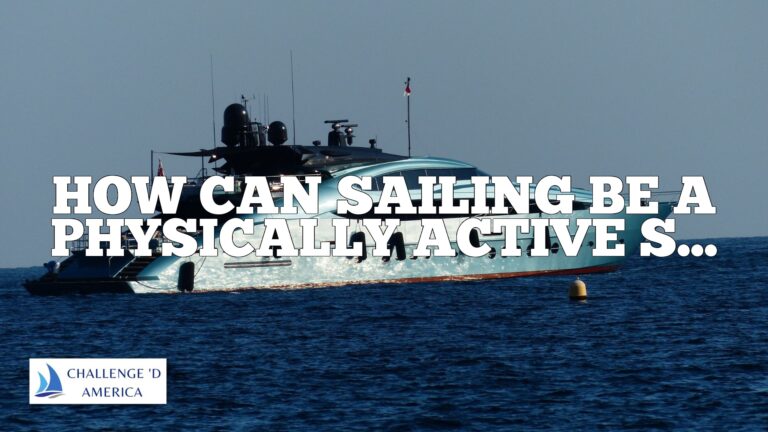What Is The Secret To Sailing a Laser Upwind?
The Secret To Sailing a Laser Upwind
Sailing a Laser upwind can be one of the most challenging maneuvers in sailing, but it doesn’t have to be as daunting as it may seem at first glance.
With some knowledge of the fundamentals, the right techniques, and an understanding of your environment, you can master sailing upwind with relative ease and confidence.
In this article we’ll take a look at the basics of sailing upwind with a laser, from understanding trim and balance to handling waves and tuning your rig for optimal performance.
What is a Laser?
A laser is a light-weight single-handed dinghy sailboat that was designed by Bruce Kirby in 1969 and has since become one of the most popular recreational sailing boats in the world due to its versatility and easy maneuverability in all kinds of conditions.
It is designed with an asymmetrical hull shape that allows it to sail well upwind, but because of its light weight it can also be difficult for inexperienced sailors to handle when sailing upwind as winds increase or waves start forming around them.
Why Is It Difficult to Sail a Laser Upwind?
When sailing upwind in any boat, there are several factors that contribute to difficulty: wind direction, wave size, boat speed, trim and balance, and proper rigging setup are all important considerations when trying to sail efficiently upwind with any boat—not just lasers—but lasers require special attention due to their light weight construction which makes them more susceptible than other boats when faced with these challenges.
Understanding the Fundamentals of Sailing a Laser Upwind
Before attempting any kind of maneuver on any kind of boat—especially one as delicate as a laser—it’s important that you understand the fundamentals of sailing upwind so you can anticipate what will happen in each situation before it happens:
- When facing wind direction: use sail shape changes or heading changes (tacking) so you can use wind pressure on the sails instead of against them,
- When facing waves: use wave size changes or boat speed changes so that you can ride over them instead of against them,
- Trim & balance: adjust sails so they create lift (instead of drag) in order for your boat to move through the water faster.
Tuning Your Rig For Optimal Performance
The last thing you need to consider when trying optimize your laser’s performance is rig tuning since this affects everything from performance under different conditions such as light winds/heavy winds etc., as well as overall efficiency under different maneuvers such as tacking/reaching etc., some tips include adjusting mast rake/cunningham tension/outhaul tension etc., depending on whether you want more power or better pointing ability etc., make sure everything is set correctly before attempting any maneuvers!Strategies For Optimizing Boat Speed And Efficiency
Once everything else is taken care off there are few strategies left that help optimize both speed & efficiency such as using proper crew weight distribution across both sides (port & starboard), using tacking strategies such as alternating between port & starboard tacks every few minutes or using zigzag patterns etc., whenever possible, also make sure everyone onboard understands what each maneuver requires from them so everyone remains aware & prepared during maneuvers!
The Importance of Trim and Balance
Trim & balance are essential for efficient performance on any boat—and especially on lighter boats like lasers—so it’s important that you understand how they work together when sailing upwind. Proper trim means having your sails set at an angle that creates lift instead of drag, too much drag will slow your boat down while too much lift will cause your bow (front) end to rise too much which will reduce your speed even further. Proper balance means having weight evenly distributed across both sides of your boat which allows it move through the water more efficiently without being pushed off course by strong winds or waves, if one side has more weight than another then your boat will be less stable which reduces speed even further.
Techniques To Maximize Trim & Balance
Once you have an understanding of trim & balance you can start incorporating some techniques into your sailing style which help maximize these two elements:Reefing: reducing sail area by folding down parts of sails when facing strong winds or large waves, this reduces drag created by sails while still creating enough lift for efficient movement,
Heel control: controlling heel (angle) by adjusting trim depending on wave size, wind direction or strength, this helps keep bow (front) end low while still allowing enough lift for forward movement.
Tips For Handling Waves
When dealing with waves it’s important that you know how they affect your laser so that you can adapt accordingly: use wave size changes or boat speed changes so that you can ride over them instead staying caught in their troughs—this helps maintain balance while also allowing forward propulsion, also keep an eye out for cross currents created by waves since they create turbulence which makes it even harder to maintain balance while trying to sail upwind, overall remember that waves are inevitable so be prepared mentally before attempting any kind maneuver in their presence!
People Vs Environment: How To Adapt To Different Conditions
The key factor when sailing in different conditions is learning how to adapt quickly depending on people vs environment factors such as weather/wave size/direction etc., this means taking into account both external factors like weather conditions/tides etc., as well as internal factors like crew weight/age/experience etc., some tips for adapting quickly include keeping an open dialogue between everyone onboard about how everyone is feeling about conditions/maneuvers etc., being aware & open minded about different techniques & strategies used by experienced sailors etc., and most importantly have fun!
Tuning Your Rig For Optimal Performance
The last thing you need to consider when trying optimize your laser’s performance is rig tuning since this affects everything from performance under different conditions such as light winds/heavy winds etc., as well as overall efficiency under different maneuvers such as tacking/reaching etc., some tips include adjusting mast rake/cunningham tension/outhaul tension etc., depending on whether you want more power or better pointing ability etc., make sure everything is set correctly before attempting any maneuvers!
Strategies For Optimizing Boat Speed And Efficiency
Once everything else is taken care off there are few strategies left that help optimize both speed & efficiency such as using proper crew weight distribution across both sides (port & starboard), using tacking strategies such as alternating between port & starboard tacks every few minutes or using zigzag patterns etc., whenever possible, also make sure everyone onboard understands what each maneuver requires from them so everyone remains aware & prepared during maneuvers!
Conclusion
Sailing a laser upwind may seem daunting at first glance but if you understand the fundamentals behind it then mastering this maneuver becomes relatively easy given enough practice time! Remember always adjust trim & balance accordingly depending on wind direction/wave size etc., use reefing techniques whenever necessary & try out different strategies until something clicks! Most importantly have fun & enjoy yourself while learning new things every day!







